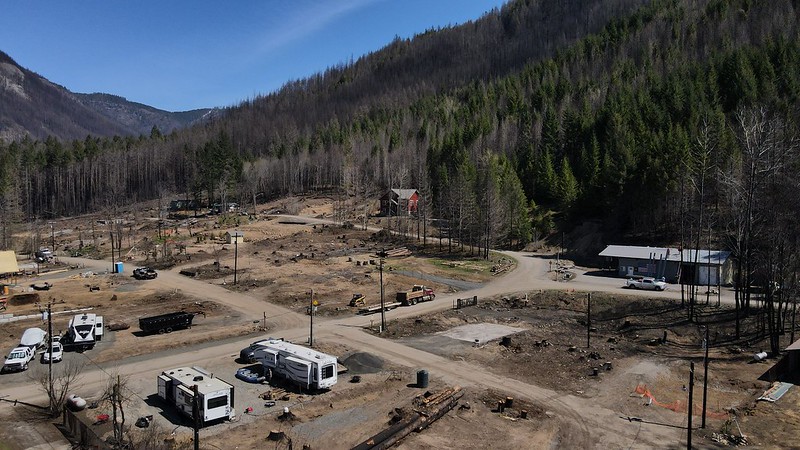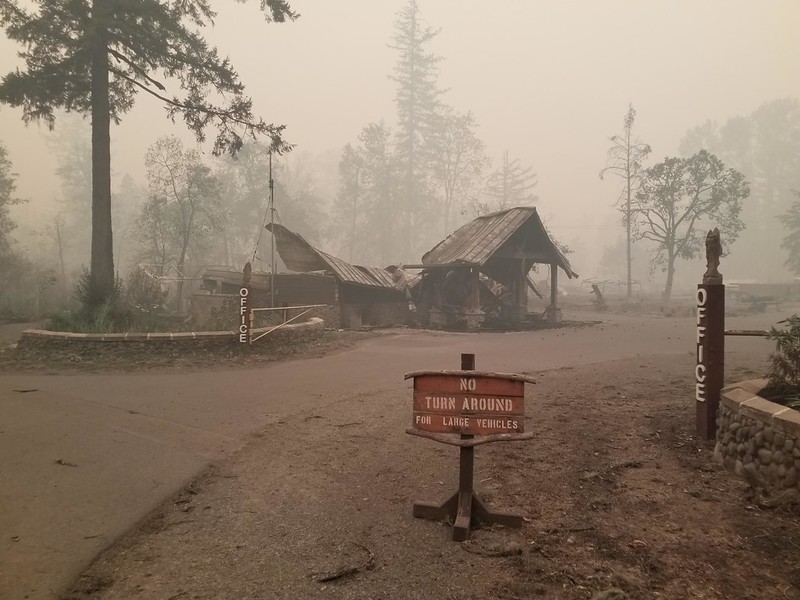“If you stay ready, you ain’t gotta GET ready.” – RuPaul Charles
We’ve all been on high alert about wildfires spreading to our homes ever since the massive destruction from the 2020 Labor Day wildfires right in our own backyard. Although that event was one of the most traumatic disasters Marion County has seen in years, there’s a lot we can learn from it to become more resilient communities.
May is National Wildfire Preparedness month! From home hardening, fuels reduction, defensible space, to evacuation planning, there are so many ways to reduce your risk of danger in the case of a wildfire spreading to your neighborhood. As we continue into the next wildfire season, here are some tips to help get ready and stay ready.
In this post
Mitigation Practices
Home Hardening
Preparing your home and property from wildfire damage starts with the home. It is recommended to start mitigating for wildfire risk by hardening your home and structures by modifying them to be more ember resilient. Once your home and buildings are protected, work outwards into the three zones around your house, then into your woodland or natural area to create a defensible space. If you are a homeowner in a WUI (Wildland-urban Interface), you may want to consider taking steps to reinforce your infrastructure and house to be more resilient against fire damage, as these areas may be at higher risk of experiencing damage from forest fires that have gotten out of control. This can help with preventing embers from entering your home, windows breaking and allowing flames inside, and materials from combusting.
Lower cost methods for home hardening:
- Regularly clean roofs and gutters from debris.
- Install window screens.
- Remove vegetation and debris from decks.
- Do not store combustibles (firewood, fuel) under the deck or against the house.
- Enclose vents, soffits, chimney or stove openings with 1/8 inch metal mesh screening.
- Install weather stripping around garage doors to prevent embers from entering the garage.
Higher cost methods for home hardening:
- Install Class A fire-rated roofing.
- Replace decking and siding with ignition resistent materials. Avoid untreated wood and vinyl siding.
- Replace single-pane windows with dual or multi-pane windows with tempered glass.
- Replace combustible fences with non combustible materials.
- Box in all open-eave construction.
Defensible Space
Defensible space is the 100 feet buffer around a structure or home where combustibles are removed and altered to reduce wildfire risk. Combining home hardening techniques with defensible space is the best way to protect your home and woodland from wildfire damage. Think “From the front door to the forest”. Everyone can ensure they are maintaining a defensible space around their dwelling unit and valuable infrastructure by removing flammable and combustible materials at least 5 to 100 ft away from the home. According to wildfire prevention experts, the defensible space around a home can be partitioned into three zones.
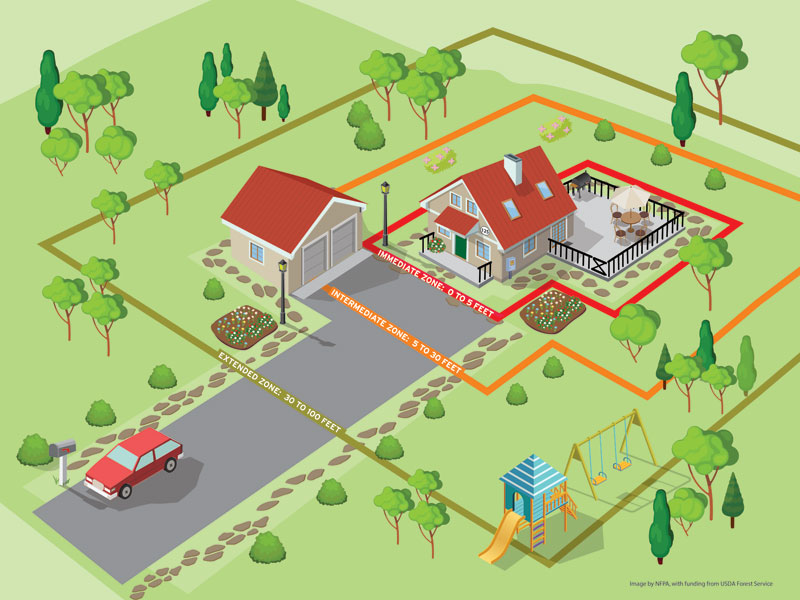
Zone 1: Immediate zone, 0-5 feet from house.
- Clean roofs and gutters of dead leaves and pine needles.
- Replace or repair any loose or missing shingles in the roof.
- Landscape with irrigated grass, rock gardens, and use stone patios.
- Replace or repair any loose or broken window screens and broken windows.
- Use non combustible materials for decking and fencing.
- Eliminate wood fencing touching the sides of the house.
- Eliminate leaf litter or wood chip mulch for gardens.
Zone 2: Intermediate zone, 5-30 feet from house.
- Remove ladder fuels by limbing trees up to 6 ft high.
- Space trees with crowns18 ft apart.
- Place woody debris, firewood, and slash piles at least 30 feet away from home
- Plant fire-resistant, low volume vegetation that retains moisture
- Separate auxiliary structures such as a detached garage, pump house, shed at least 50 feet away from the home.
- Plant native plants in clusters to cut off fire path.
- Create a fire break with paved roads, paths, and patios.
- Keep lawns and native grasses mowed and irrigated.
Zone 3: Extended zone, 30 -100 feet from house.
- Reduce fuels in woodlands by removing dead woody debris.
- Thin small conifers growing between mature trees.
- Trees 30 to 60 ft from the house should have at least 12 ft between canopy tops.
- trees 60 to 100 ft from the house should have at least 6 ft between canopy tops.
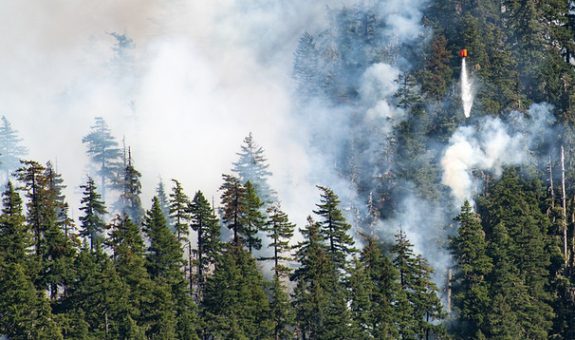
Resources for Defensible Space and Home Hardening
Emergency Plans
In addition to modifying your home and woodlands to ensure they are resilient against wildfire, it is essential to have your family prepared for the case that you may need to evacuate your home. Marion County residents have been evacuated for wildfire nearly every summer in recent years. To make sure you, your family, and your animals are safe and comfortable in the face of a natural disaster emergency, it is important to have a kit or go-bag ready to take at last minute notice.
Here are some steps you can take to be ready for an unexpected emergency:
- Make a go bag and emergency kit – basic supplies include enough water for each person for multiple days, non-perishable food, battery or hand crank powered radio, flashlight with batteries, first aid kit, medications, whistle, dust mask, personal sanitation supplies, local maps, portable cell phone chargers, blankets, spare clothes, and more. Visit ready.gov to learn more about what to pack in your kit.
- Make an evacuation plan – practice the plan at least once per year with your family. Visit ready.gov to learn how to create a plan.
- Be familiar with evacuation routes, subscribe to local emergency notification systems. Learn more and sign up for emergency alerts at Oregon Wildfire Response and Recovery.
- Ensure safe access to home by fire fighters, invite them to your property before hand to make sure the roads are accessible. Find your local fire station and district near you here.
- Insure and document your property.
- Safeguard important documents.
Create a plan for evacuating and protecting your pets and livestock.
- Visit Pet Disaster Preparedness to learn more.
- Watch OSU’s Wildfire, Smoke, and Livestock webinar series.
- For horses, use the emergency evacuation planning checklist for horses.
- Follow USDA’s checklist for livestock preparedness.
As part of the Oregon State Fire Marshal’s wildfire preparedness month, we are giving away wildfire safety kits to provide resources to help you get started on building an emergency preparedness kit and to spread the word to friends and community members about wildfire preparedness. Please order your free kit for pick up on our website catalog here: Wildfire Safety Kit. Kits are also available in Spanish!
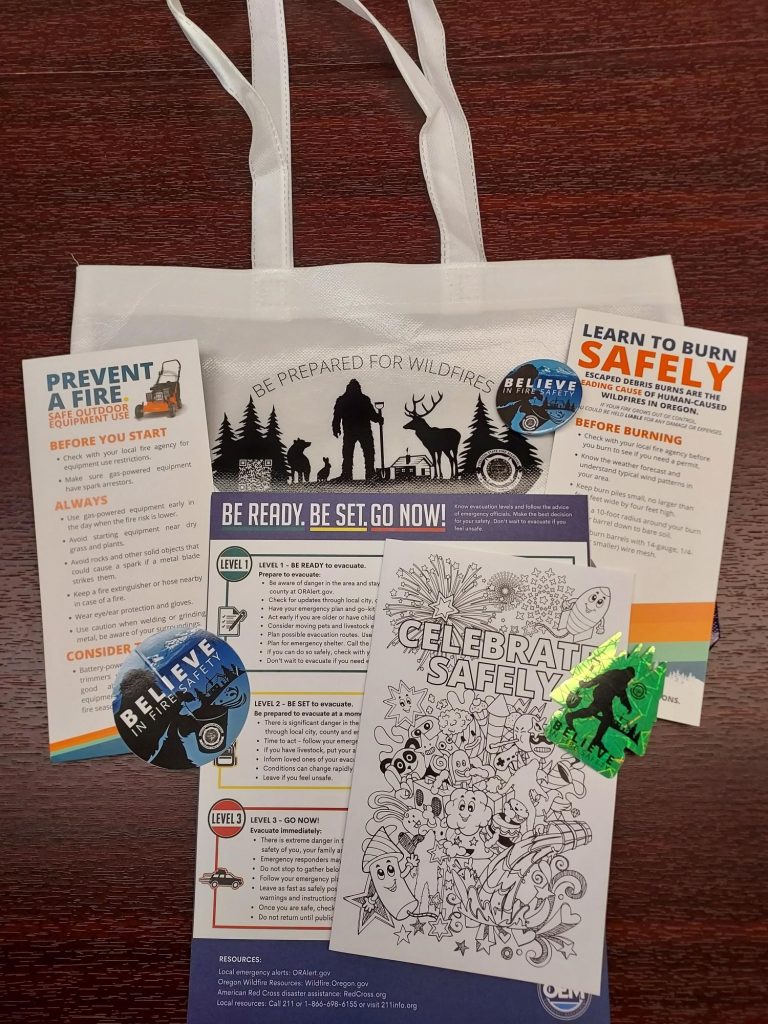
Response and Evacuation
Once you have prepared your home and family to mitigate and prepare for wildfires, be ready to spring into action at any point during peak wildfire season. Our wildfire season has been extending, starting earlier in the summer and lasting well into early fall, due to changing climate conditions. Stay informed about local emergency alerts and natural disasters that are in effect near you. Check the current conditions on disaster and evacuation notices in Marion County on the Marion County Emergency Response Hub.
Become familiar with the Ready, Set, Go! Emergency Evacuation Levels, and stay updated on what level is in effect near you.
- Be Ready – Level 1 evacuation notice means to be ready for a potential evacuation due to a wildfire that may be encroaching near your county or neighborhood. This means having your emergency Go-bag or kit updated and fully prepared with all the necessary supplies. Your family should be communicating and practicing your evacuation plan. You should also be ensuring that your defensible space is ready, and all combustible items are at least 30-100 feet away from your home.
- Be Set – Level 2 evacuation notice means you must prepare to leave at a moments notice. This is when you and your family should have all of your valuable and necessary items ready to pack in the car and leave as soon as you get a notification from Marion County emergency management to evacuate your home. You should also know exactly what to do to follow your evacuation plan. You should be checking the Marion County Emergency Hub for updates regularly and communicating with neighbors and family. It’s important to be aware that in some cases when wildfire spreads quicker than emergency management can notify residents, this may be the only warning you receive before the wildfire is on your doorstep – stay alert and vigilant. Be ready to make the call to keep your family safe and leave your home even if you don’t receive an official evacuation notice from the county.
- Go – Level 3 evacuation notice is when you are instructed to leave immediately. If you receive this notification, it means it is too late to pack a bag or gather any valuables you want to keep; you need to grab your family and animals and leave your home as soon as you receive this notification. If you choose to ignore this notification, the emergency services may not be able to assist you, as this would be putting fire fighters and emergency responders at risk of their own lives. Entry to evacuated areas may be denied until conditions are safe. Use your battery or hand crank powered radio in your emergency kit to stay informed about local updates. Get to a safe refuge and wait out the wildfire with your family.
Get Involved!
Take action and complete the Marion County Community Wildfire Protection Plan Survey to give feedback on what you want to see in the updated plan. It’s important to get feedback from those impacted by the previous fires, to learn how we can build stronger communities for the future. This survey closes at midnight on June 30, 2024. Read the full 2017 version of the plan here: Marion CWPP.
